Research Methods
Description in Scientific Research
Did you know?
Did you know that not all scientists conduct experiments? Anthropologist Jane Goodall was doing scientific research when she spent years in African forests watching chimpanzees and recording her systematic observations. Description has been used to develop theories in many scientific fields, including astronomy, geology, and primatology.
An eclipse is a dramatic event: the sky goes dark during the day in a solar eclipse, and the moon turns red during a lunar eclipse. As a result, many cultures have revered both solar and lunar eclipses, and their occurrences are noted frequently in prehistoric art, oral histories, and historical records. The Chinese began systematically recording the time and location of eclipses on what they called oracle bones as early as 2000 BCE. Astronomers in ancient Mesopotamia kept detailed records of lunar eclipses engraved on 70 tablets dating back to 600 BCE (such as shown in Figure 1), and these records were used to accurately predict future eclipses (Steele, 2000). By the 4th century BCE, the Mesopotamians had developed a comprehensive lunar theory from these observations – a mathematical description of the movements of the sun and moon through the sky – that was the first of its kind (Britton, 2007).
These records define an early stage in the development of the science of astronomy, which relied on quantitative description as a research method. The ancient astronomers observed and described the motion of objects in the sky, noted the time and location of events, developed mathematical models based on the phenomena they observed, and then used those models to predict future eclipses through mathematical computations.
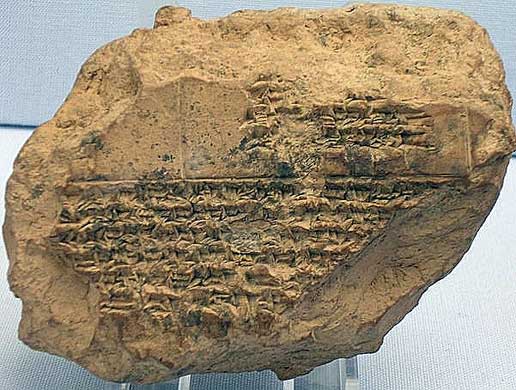
Around 340 BCE, the Greek astronomer Eudoxus developed his own geometrical theory of the universe (Goldstein & Bowen, 1983): He proposed that the universe consisted of nested spheres with a non-moving Earth at the center. This theory was based on his recorded observations of the paths that planets took through the sky, and the relationships of the planets to the Earth, moon, and sun. However, Eudoxus was not able to quantify these relationships and thus was unable to use his observations predictively. In the 2nd century BCE, the Mesopotamian records reached Greece, and the mathematician Hipparchus revolutionized Greek astronomy by combining Greek and Mesopotamian observations and descriptions.
Though the exact method of transmission of ideas is not clear, the presence and use of these long-term descriptive records was at the core of the development of the science of astronomy. Those early data are so significant, in fact, that they are still being revisited today: Both the Chinese and Mesopotamian eclipse catalogs have been used by modern scientists to approach new scientific questions, like measuring the rate of slowing of Earth's rotation over time (Pang, Yau, Chou, & Wolff, 1988).
Description as a scientific research method
These early astronomers used descriptions of natural phenomena to make scientific inferences about broad physical principles, like the rotation of the Earth or the nature of the solar system. As discussed in The Practice of Science module, all research methods involve data gathering and hypothesis development and testing, and the descriptive method is no different. This method usually involves the following steps:
- The systematic observation and detailed description of a phenomenon in a manner that could be replicated – for example, the frequency of lunar eclipses, the composition and orientation of rock layers in Utah, or the behavior of chimpanzees in the wild.
- These and sometimes other lines of evidence are used to develop a hypothesis or multiple working hypotheses to explain the phenomenon.
- Additional observations or other types of research are conducted to test the hypothesis or to determine the likelihood of the competing hypotheses.
- Eventually, an explanatory theory that fits the observations and evidence can be developed.
This is an iterative process that happens on many scales: The entire process may happen within a few days for one scientist, or over many decades or centuries and involving the contributions of many scientists, sometimes from many fields of science.
Descriptive studies can also be exploratory rather than driven by hypothesis testing. The US Geological Survey, for example, maintains stream gauges on many streams and rivers in the United States, which record daily observations of the amount of water flowing at that point. These were not established to test any specific hypothesis, but simply to keep a record. The records have proven useful in addressing questions about flood recurrence intervals, daily and seasonal fluctuations in stream flow, and other watershed-related questions. Not all descriptions of streamflow are scientific, however. Part of the reason that these records are so useful is because the descriptions are systematic, and involve the same rigor and consistency that is required in designing a well-controlled experiment (see our Experimentation in Science module) or in building a useful mathematical model (see our Modeling in Science module). The location of each stream gauge was surveyed and calibrated to accurately record the flow. Streamflow is measured at the same time each day, and in the same location. The same parameters are recorded each day at each station, including stream height, water temperature, and volume of flow. Without that consistency, it would be difficult to establish the accuracy and reliability of the data that were collected.
Though it can stand alone as a research method, systematic description is often a component of other types of scientific research. Scientists who conduct experiments must first study and describe the system with which they experiment, researchers who initiate comparative studies need descriptive data regarding the population they are investigating, and scientists who build models must have an accurate representation of the system they are modeling.
Description in practice: G.K. Gilbert and the geology of the Henry Mountains
In the United States, description was used as a scientific research method extensively during the exploration of the west. In the 1860s, the US government launched a series of four surveys into the American west: The King, Wheeler, Hayden, and Powell surveys lasted from 1860 until 1879. Each of these survey teams included a geologist whose job was to observe and describe the landscape. The geological exploration of the Henry Mountains in southern Utah provides insight into the research method of description and one of its most respected practitioners, G.K. Gilbert.
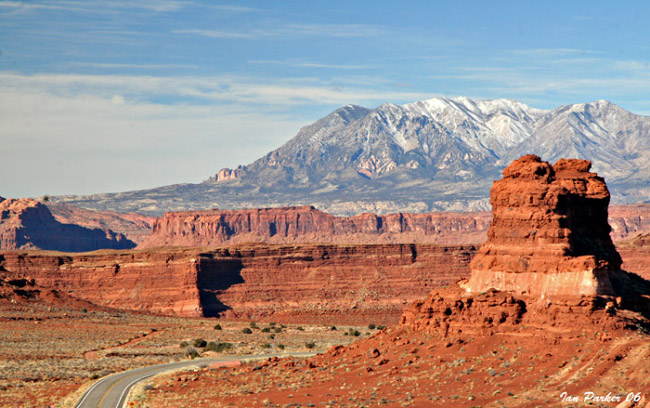
On his two trips down the Colorado River in the 1870s, John Wesley Powell had noted the Henry Mountains with interest. They lay west of the river as it wound through Glen Canyon, rising abruptly from the surrounding mesas. Their dark peaks contrasted sharply with the light-colored, layered rocks that surrounded the river on all sides (see the photo in Figure 2). Powell did not have time to explore the mountains himself, and thus gave the task to Grove Karl Gilbert, a young geologist who had worked with him previously. Gilbert spent a week in the mountains in 1875, and returned for a month in 1876, emerging with several notebooks filled with carefully recorded notes, sketches, and hypotheses. In August of 1875, he wrote the following observations:
…The rock which rises towards Hillers from the south is the B Cliff. It is lost in the 'debris' without increasing the dip (7°) with which it approaches. But beyond are red and white sands – [deeper] rocks tilted almost to the vertical and interspersed with dikes. Moreover these sandstone hogbacks seem to trend in a curve around the mountain as far as they extend.
He make a sketch, shown in Figure 3 below, in which he indicated where he had taken measurements and summarized his descriptions.
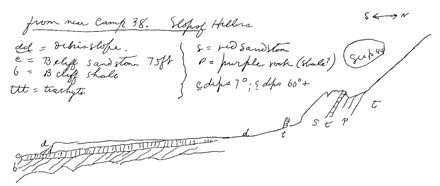
Gilbert collected samples of each of the rock types labeled in Figure 3 and described them. The layered rocks (labeled b, c, d, s, and p in Figure 3) were all sedimentary rocks that he had seen before in his travels, and he described them by color, grain size, and the fossils they contained. The core of Mt. Hillers was different, however: an igneous rock formed from cooling magma. He described this rock as "a pale gray paste with large white crystals of feldspar and crystals large and small of hornblende." Based on this composition he determined it was trachyte, labeled t in Figure 3. Gilbert sketched the same mountain from several different angles and collected measurements on the orientation of rock layers all the way around it, while also collecting basic survey data like elevation.
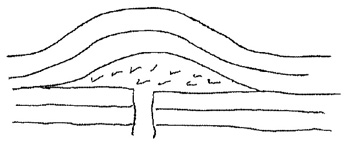
Just a few notebook pages and one day later, Gilbert takes the first leap from observation and data collection to hypothesis. He sketches a cross-section that is no longer a faithful depiction of the landscape, but is a hypothesis for the formation of Mt. Hillers (Figure 4). This initial model takes all of his observations thus far into account: the gentle slopes of the sedimentary rock units leading up to the peak, the steeply dipping rocks that continue all the way around the mountain, and the igneous rock at the center. He devotes little text to explaining his idea at this point, writing only about a "reservoir" of magma forming below the surface and deforming the rock layers above it. He knew he had more data to collect in order to test this initial hypothesis; the next day, he wrote in his notes, "I don't understand the NE side of Hillers." He could not yet explain what was going on there through his initial hypothesis.
Gilbert had only a few days left in the Henry Mountains that summer as he continued on his exploratory journey. The next year (1876) he returned, however, to the task of collecting more data to revise his initial, simple hypothesis. After a month of collecting survey data and rock unit orientations, Gilbert and his team were stuck in camp because of rain and snow. Gilbert took the opportunity to summarize his findings and display the development of his thinking over the course of his explorations. He re-drew the sketch from the previous year and wrote an explanation for his new model:
The simplest type of Henry Mt. structure is a lenticular mass of trap [an early word for igneous rock] above which the strata were arched... The form of the trap mass is never fully shown but it can be described in a general way in several cases... Injections are combined and grouped variously. A trap mass with sheets above and below may be regarded as a system of exudations from one chimney.
He includes a more realistic representation of the process as it applies to the Henry Mountains specifically (Figure 5). Gilbert then poses a question about these intrusions: Why didn't the magma reach the surface?
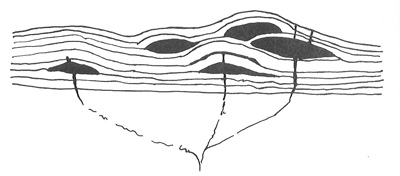
Gilbert published his "Report on the Geology of the Henry Mountains" in 1877 (Gilbert, 1877). In the publication, he named this newly discovered type of intrusion a laccolite (later changed to laccolith). He formalized his field sketches, measurements, and research questions into a coherent theory about the formation of the Henry Mountains and noted that many other mountains in the region were likely formed through the same process. He proposed two different answers for his question about the underlying causes of the intrusion relating to relative densities and the "penetrability" of the sedimentary rocks, but his question has still not been resolved today. Gilbert's report is considered a key milestone in geology, not only for the new type of intrusion he proposed, but for the highly systematic way in which he used the descriptive method of science; as a result, Gilbert went on to become a highly valued and respected leader of the new US Geological Survey and two-time president of the Geological Society of America.
Gilbert's work also laid the foundation for further research on the Henry Mountains. More detailed measurements of the folding and faulting in the rock layers gave strong support to Gilbert's laccolith hypothesis (Jackson & Pollard, 1988). More recently, researchers have experimented with physical analogue models to try to understand why the magma did not make it to the surface by building sedimentary layers out of sand and injecting the layers from below with silica gel to simulate magma (Roman-Berdiel, Gapais, & Brun, 1995).
Comprehension Checkpoint
Drawings may be used both to describe observations and to propose hypotheses.
Description across disciplines
Description as a research method is not a thing of the past, nor does it consist solely of sketches. Ongoing measurements of CO2 concentrations in the atmosphere, such as those begun by Charles Keeling on the Hawaiian volcano Mauna Loa in 1958, are a quantitative description of the composition of the atmosphere over time (see The Carbon Cycle module). These daily, worldwide measurements have allowed climate scientists to develop hypotheses about the atmospheric response to volcanic eruptions, pollutants, and the steadily increasing emissions of greenhouse gases. The atmospheric record has been extended back 650,000 years through the sampling and description of CO2 concentrations in air bubbles trapped in ice cores drilled in Greenland and Antarctica (Figure 6). These data reveal a cyclical pattern in CO2 concentrations that has helped climate scientists develop an understanding of long-term climate. Based on these findings, climatologists can develop models to assess the possible impacts of a continued increase in CO2 concentration in the atmosphere.
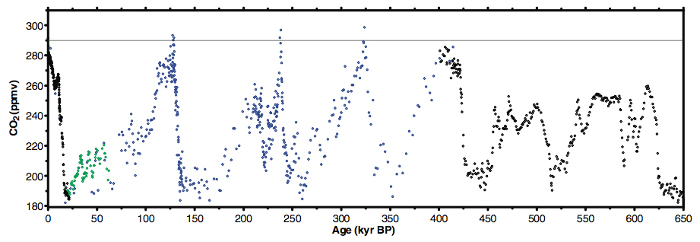
In contrast with experimentation, sometimes the main goal of the descriptive method is explicitly to avoid manipulating any variables, such as in some ecological studies that seek to describe the natural interactions between organisms in the environment. Jane Goodall's goal in the Gombe National Park in Tanzania when she began working there in the 1960s was the non-invasive observation of chimpanzees in the wild. One of her first papers, "Tool-using and aimed throwing in a community of free-living chimpanzees," published in 1964, opened with the fact that tool-use had been observed in chimpanzees in captivity, but many people wanted to know if the behavior existed in wild populations.
In order to answer this question, Goodall observed chimpanzees in their natural habitat and took detailed notes. Goodall's work involved long days, weeks, and months in the field. In the beginning of her study, she simply sat near the chimps to assure that the animals would become comfortable with her presence and would act normally, as she did not want her presence to be a variable affecting their behavior. Goodall then placed boxes full of bananas in areas where she knew the chimpanzees would find them. The kinds of data she presented in her paper included descriptions like the following:
After pulling and pushing at the boxes for up to 5 min., each one broke off a stick and stripped it of its leaves. Two individuals then tried to push their sticks under the box lids.... None of the three had seen either of the others trying to solve the problem in this way.
It is important to recognize that Goodall did manipulate the environment (she gave the chimpanzees something new to look at – boxes of bananas), but she did not attempt to manipulate their behavior – that was the object of her observations and descriptions. She used these and other observations to develop new ideas about chimpanzees as tool-users who think independently and can learn from one another (Goodall, 1964), revolutionizing our understanding of non-human primates and human origins.
In fact, Goodall was performing an experiment, in a sense, with the chimpanzees: What will they do with a sealed box of bananas? That particular research question falls somewhere on a continuum between experimentation and description, and highlights how different research methods complement each other. It is particularly common that experimentation and description overlap: Another example is NASA's Deep Impact mission, which is described in our Experimentation in Science module.
Comprehension Checkpoint
One goal of descriptive research can be
Limitations of the descriptive methods
Description is very widely used throughout scientific research, and there are few limitations on its use. It is a very useful research method for questions where experimentation is impossible, such as determining events in the history of Earth. Despite the wide applicability of the method in science, it is challenging to establish cause and effect relationships through description alone. Instead, descriptive studies lead most often to information about the function or form of phenomena, like Gilbert's work, and the establishment of physical, spatial, and temporal relationships.
Systematic description can also easily lead to unscientific explanations, as is evident in the mythologies and legends of many cultures. The early Greeks were excellent observers of their environment, and they developed mythological explanations for natural processes that we now understand in a scientific sense. For example, like most agricultural peoples, the Greeks observed and monitored the change of the seasons, the regular cycle of budding and growth in the spring, followed by a season of abundance in the summer, the fall harvest, and barren fields in the winter. These observations are encapsulated in the myth of Demeter, the goddess of agriculture, and her daughter Persephone, who was kidnapped by Hades and taken to the Underworld. In the myth, Demeter strikes a deal with Hades to share Persephone – for six months of the year, Persephone lives with her mother on the surface, and Demeter's happiness is reflected in the seasons of spring and summer, while the six months when Persephone returns to the Underworld are marked by Demeter's grief, and the crops wither and die. Clearly, the observations of seasonal changes are valid, but the mythological explanation is not scientific.
In some cases, even descriptions that weren't meant to be scientific at the time can be utilized by scientists later. For example, many historical figures have been diagnosed with diseases or afflictions long after their deaths by historians and scientists who peruse diaries, letters, and other primary sources for descriptions of symptoms.
In 1979, Peter Spargo, a chemist at the University of Cape Town, teamed with a forensic scientist, C.A. Pounds, to determine the cause of an episode of "madness" experienced by Isaac Newton in 1692-93. Many historians had noted oddities in Newton's behavior during this time as reflected in his letters and records. Based on the descriptions of his actions contained in these letters and records, Spargo and Pounds summarized the symptoms of Newton's illness as "severe insomnia, extreme sensitivity in personal relations, loss of appetite, delusions of persecution, and amnesia." They noted that during this same time period, Newton was engaged in intense alchemical experimentation and hypothesized he was experiencing heavy metal poisoning (Spargo & Pounds, 1979). In other words, though the descriptions of Newton's behavior were not meant to thoroughly document his ailment, they were still useful in developing a scientific hypothesis. Spargo and Pounds were able to test their hypothesis by obtaining a sample of Newton's hair, which indeed revealed significantly elevated levels of mercury, arsenic, gold, chlorine, antimony, and lead – all metals capable of producing temporary neurological disorders such as those he experienced.
Description in modern practice
Although many scientists still sketch their descriptions with pencil and paper, the tools available for descriptive studies have proliferated and grown more powerful. For example, the use of X-ray diffraction allows geologists to go beyond a field description of a rock to a detailed description of the chemical make-up of individual minerals (see our module, The Silicate Minerals). This same technique allowed Crick, Franklin, Watson, and Wilson to describe the structure of the DNA molecule as a double helix (see our DNA II: The Structure of DNA module). Other instruments, like mass spectrometers make it possible to determine the absolute ages of things like lavas from volcanic eruptions and bones from archaeological sites, whereas scientists like Gilbert, who worked before such technology was invented, could only assign relative ages to the rocks he studied. Many of our most advanced and costly technologies are based on making highly accurate descriptions: For example, global positioning satellite (GPS) technology allows ecologists, oceanographers, and many others to accurately pinpoint their sample locations and make more detailed analyses of spatial data; magnetic resonance imaging (or MRI) allows us to see our the organs inside our bodies for more accurate medical diagnoses. These techniques are in use today in a variety of scientific disciplines, bringing new understanding to large-scale, complex, interacting systems.
Summary
Observation is an important tool for scientific researchers, and describing what is observed is a valuable method of research. This module explains key features of scientific description and discusses how this method is used in the process of science. Examples from history illustrate the use of description, from the geologic exploration of the US in the 1800s to 20th century studies of primate behavior.
Key Concepts
- Description involves the systematic observation and cataloging of components of a natural system in a manner that can be utilized and replicated by other scientists.
- Description is commonly used as a research method to explain unique natural systems (such as in ecology or chemistry), large-scale phenomena (such as in astronomy), or past events (such as in geology or forensic science).
QUIZ
- Why is G.K. Gilbert's drawing, shown below, considered a hypothesis about the formation of the Henry Mountains?
- Taking measurements of CO2 concentration in an ice core from Antarctica is considered descriptive scientific research because
- Description is often used in conjunction with other research methods, including experimentation, modeling, and comparison. Why is this the case?
- A descriptive study of the impacts of hurricane-force winds on a new home would include
- In order to be useful in scientific research, description must be
- In order to use description as a research method, a scientist must manipulate variables.
- Scientists have been able to use historical descriptions of events like the eruption of Mt. Vesuvius to conduct scientific investigations because

(A)__In descriptive research, sketches are often used in place of data.
(B)__Gilbert summarized his data and suggested a cause for mountain formation in the sketch.
(C)__He made the hypothesis before he went to the Henry Mountains to collect any data.
(D)__Gilber planned to perform an experiment that looked like the drawing.
(A)__the data are quantitative.
(B)__the data have been validated by other ice cores.
(C)__the meansurements go back 650,000 years.
(D)__there was no manipulation of variables.
(A)__Description is the easiest scientific research method.
(B)__Systematic observations are necessary in all research methods.
(C)__Description can't stand alone as a research method.
(D)__All of the answers are correct.
(A)__a survey of a group of homes following a recent hurricane.
(B)__an analysis of the damage done to a similar home in a wind tunnel.
(C)__a review of building codes in the community where the home is located.
(D)__a calculation of the force needed to cause mechanical failure of the walls of the home.
(A)__the descriptions are detailed and systematic, even if they weren't made by scientists.
(B)__the amount of data for historical events is significant.
(C)__the people who wrote descriptions were all scientists.
(D)__they are descriptions of events that were witnessed first-hand, so they are accurate.